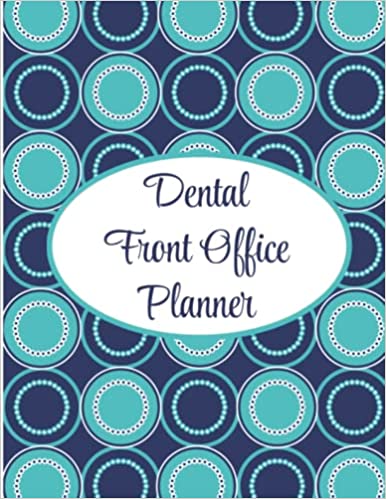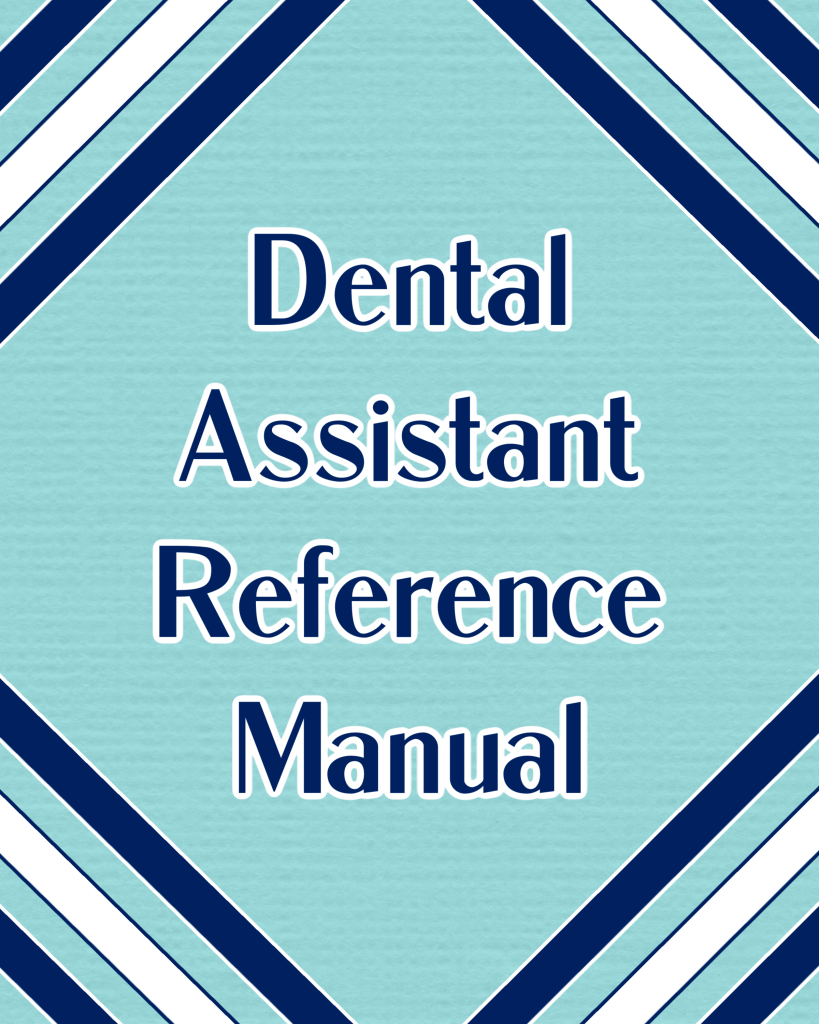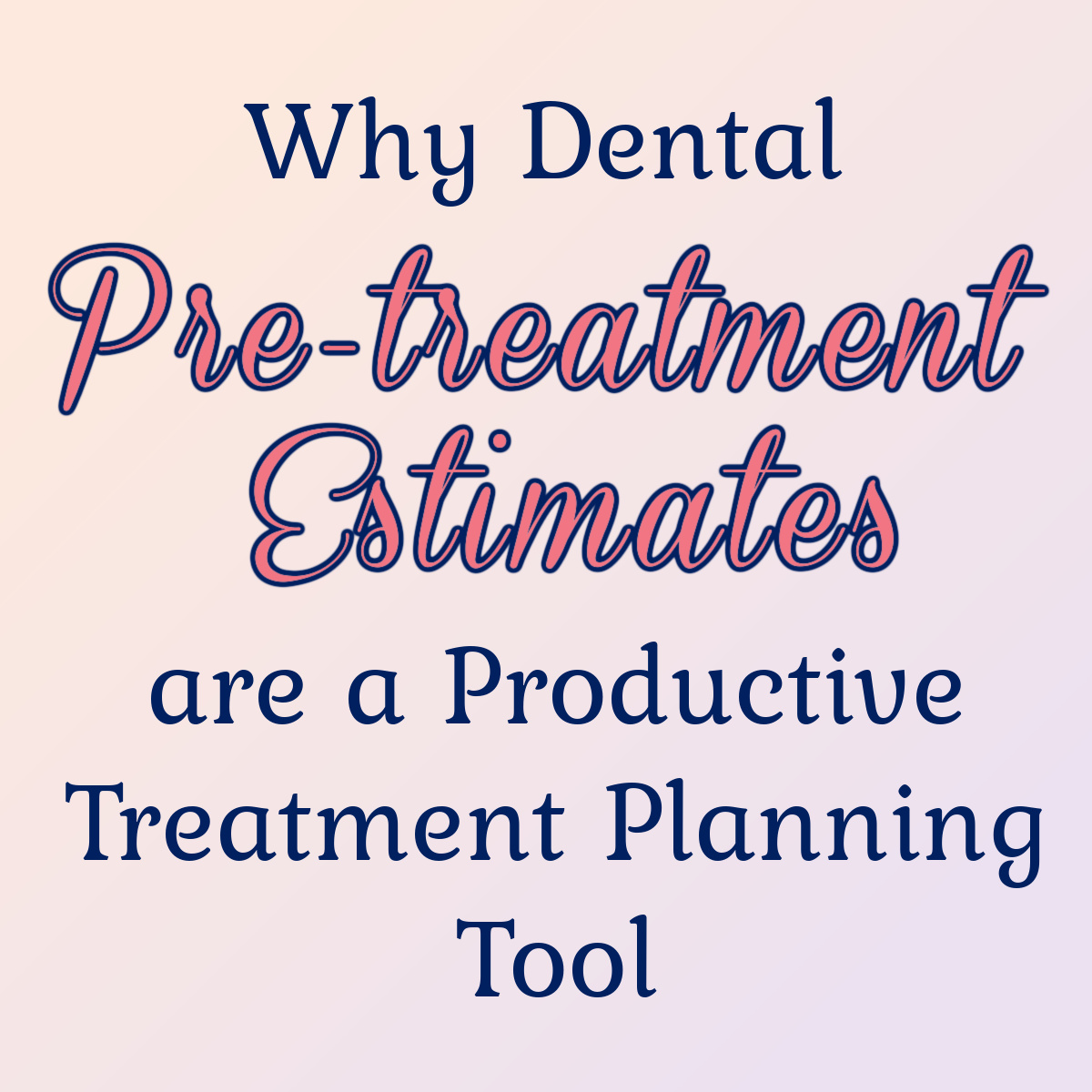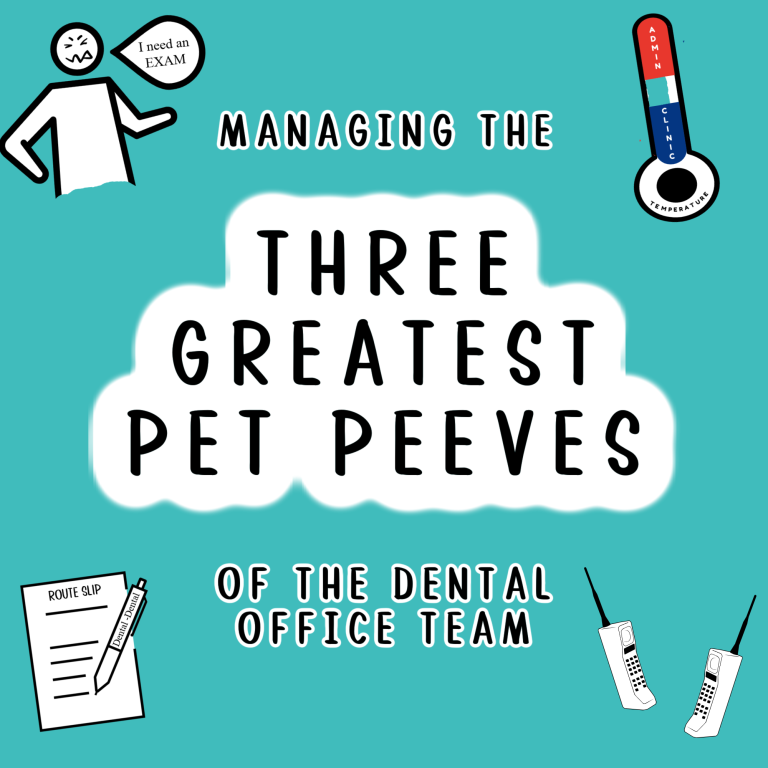Why Dental Pre-treatment Estimates are a Productive Treatment Planning Tool
Last Updated on October 30, 2023 by Anna Baumann
Why Dental Pre-treatment Estimates are a Productive Treatment Planning Tool
If you have anything to do with dental office treatment planning, scheduling, or insurance claims, you probably have strong opinions about pre-treatment estimates. My two-cents is that although they’re not perfect, they’re also not a complete waste of time. So, I’d like to share my thoughts on them. In this post, I’ll explain why dental pre-treatment estimates are a productive treatment planning tool and share my tips for using them. But before I do, let’s address some of the most common arguments against them.
Common Complaints for Dental Pre-treatment Estimates
Not guarantee of payment.
A pre-treatment estimate is a snapshot of a patient’s benefits and eligibility in that moment. I mean that literally. Treatment timing, multiple providers, and yearly maximums create infinite variables. So, it’s impossible to predict if the full estimated benefits displayed on a processed pre-treatment estimate will truly be available on the date of service.
Reality check: I know it’s a bummer and yes; pre-treatment estimates are not a guarantee of payment. But, NO dental coverage information is a guarantee of payment because insurance companies guarantee NOTHING until they process a claim. I’m always puzzled when I hear Insurance Coordinators and Office Managers say they don’t use pre-treatment estimates because “they’re not a guarantee of payment”. Yet they spend hours plugging in fee schedules and getting detailed benefit breakdowns, which are equally not a guarantee of payment.
Prohibits same-day treatment.
You can’t send a pre-treatment estimate if you diagnose and treat the same day. Depending on the insurance company, you need anywhere from a couple of days to a couple of weeks for processing.
Reality check: Occasionally we’re presented with emergency situations that leave Doctor no choice but to proceed with immediate treatment. But we all know the strain and frustration that performing same-day treatment puts on our scheduled patients, and our team. If you aren’t a dedicated walk-in clinic, but consistently add unplanned treatment to your scheduled day, you probably have bigger problems than deciding whether or not to send pre-treatment estimates.
It’s an extra step.
We must submit pertinent x-rays, photos, narratives, etc., when we submit a pre-treatment estimate. Just as if it were an actual claim. Then, attach the pre-treatment estimate to submit the claim when we complete treatment.
Reality check: I’m sure it felt like a lot of work back in the day when insurance forms were paper, filled out by hand, and sent through snail mail. But technology makes the process a breeze. Now, we can prepare and submit claims, including attachments, in about three minutes. So yes, it’s an extra step. But the second step is super simple because we do all the work in the first step. 🙂
Benefits of Dental Pre-treatment Estimates
Define plan limitations and exclusions:
Pre-treatment estimates offer valuable, code-specific information. The only other way to get this information is to submit an actual claim. So, while they may not guarantee payment, you’ll definitely appreciate the advanced notice they provide. For example:
- They tell us whether or not a submitted code is a covered benefit, and if the patient is eligible for those benefits
- We get a heads-up and an explanation for denials
- We’re informed of benefit downgrades and alternate benefits
- We know, before treatment starts, if the insurance company requires additional information
Comfort patients:
We all want full schedules. But, full schedules that fall apart because patients are hesitant about their financial obligations aren’t productive.
Treatment acceptance and appointment retention increase exponentially when our patients trust us. Most patients don’t know or understand much about their dental insurance coverage. They appreciate knowing we’re here for them and that we’re making every effort towards helping them figure things out. A pre-treatment estimate is tangible proof that we’re doing that.
Improve patient portion accuracy:
By now they’re used to us telling them that their out-of-pocket portion is an estimate. But it benefits us both if we get as close as possible to their full patient portion amount. Pre-treatment estimates are the best tool we have for pinpointing our patients’ out-of-pocket portions.
Tips for Treatment Planning with Pre-Treatment Estimates
Start with good record keeping.
Most of the information required for claim (and pre-treatment estimate) submission is the same clinical documentation we need to keep thorough patient records. Dentists need x-rays, photos, and charting to diagnose treatment. Then, they compose chart notes that describe their findings and reasons for diagnosis. If you consistently find yourself without the information you need to send pre-treatment estimates (or claims), your clinical team might need help.
Create a list of your most-used procedure codes, noting the information commonly required to submit claims for each one. Have a short team powwow to review it and set expectations. Then, laminate it and place copies in operatories and strategic front office areas.
Take this step even if you never plan to send pre-treatment estimates. It’s important because, regardless of their insurance status, a patient’s dental record is a legal document. The list reminds the clinical team to be diligent with their record keeping. It also serves as a reference for the administrative team and ensures that they send clean pre-treatment estimates and claims.
Give yourself some lead time.
When a patient’s out-of-pocket portion is estimated to be $200 or more, schedule their appointment ten days to two weeks out. Not only does it give you time to submit and receive a pre-treatment estimate, it helps you build trust with your patients because:
- It feels like a thriving practice. (If you offer them a two-hour appointment in two days, its human nature for them to wonder if your open schedule is the reason they need two crowns.)
- Unless they’re in severe pain, they appreciate you taking the time to check with their insurance.
- They can see that their pre-treatment estimate states, “This is not a guarantee of payment”. Which aligns with what you told them when you presented their treatment plan.
If you’re in the habit of accessing ERA information through insurance portals, you know the turnaround time for claims and pre-treatments estimates (with proper documentation) is about a week to ten days. If you’re not in the habit of using insurance portals, set up logins for all of them. You’ll open yourself up to a wealth of information and convenience!
Create Systems
Systems are the best. They’re comforting, they make us look and feel efficient, and they help us remember stuff. If you don’t have one already, create step-by-step plans for patient release, scheduling, financial arrangements, and claims submission. For treatment with an estimated patient portion of $200 or more, include:
- Make financial arrangements, emphasizing that the patient portion due at the time of service is an estimate
- Schedule the appointment
- Schedule it ten days to two weeks out
- Let the patient know you will submit a pre-treatment estimate to get a closer estimate of their out-of-pocket portion
- Submit a pre-treatment estimate
The scheduled appointment creates a deadline, so implement daily follow-up for pre-treatment estimates. The team member in charge of follow-up should:
- Generate a report for those that are five days old or more.
- Verify that the insurance companies received them
- Ensure they don’t require additional information or (if necessary) submit additional information
- For processed pre-treatment estimates
- Review and note information in agreed upon areas, e.g., the patient’s chart or the appointment screen. (The steps you implement for communicating processed pre-treatment estimate details with your team is super important. The information is useless if everyone can’t find it when they need it.)
- File/save documents so you can attach them to actual claims
- Share the information with patients using their preferred contact method
I hope this viewpoint nudges you to at least try using pre-treatment estimates. They truly are the most comprehensive “not a guarantee of payment” information we can get from an insurance company.



.







